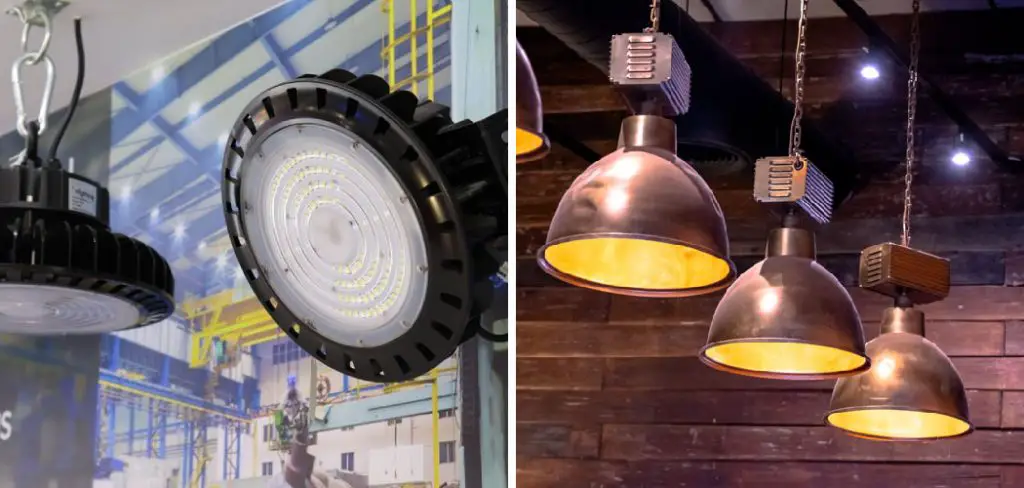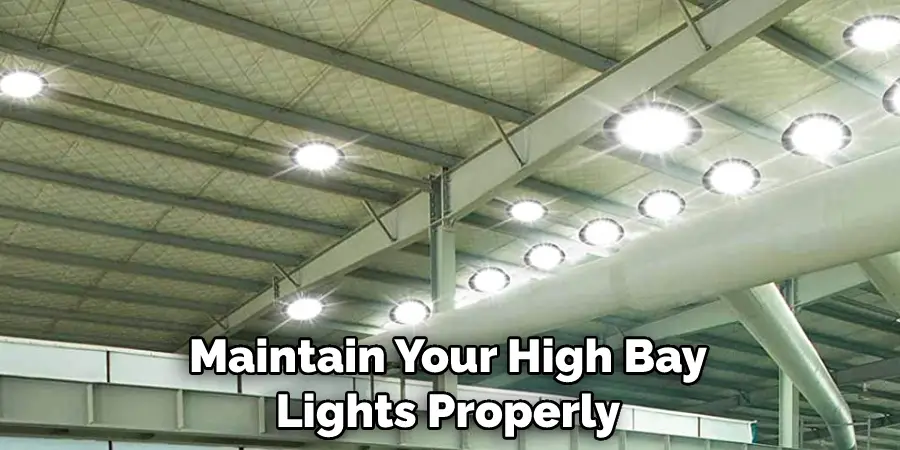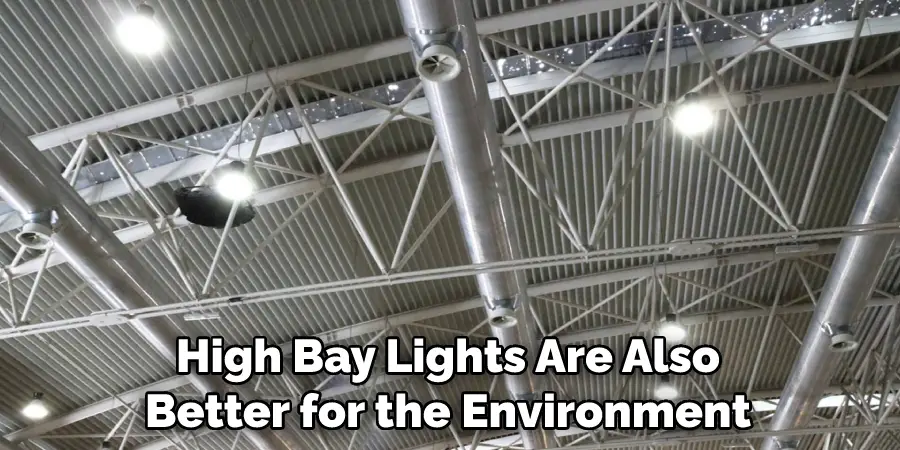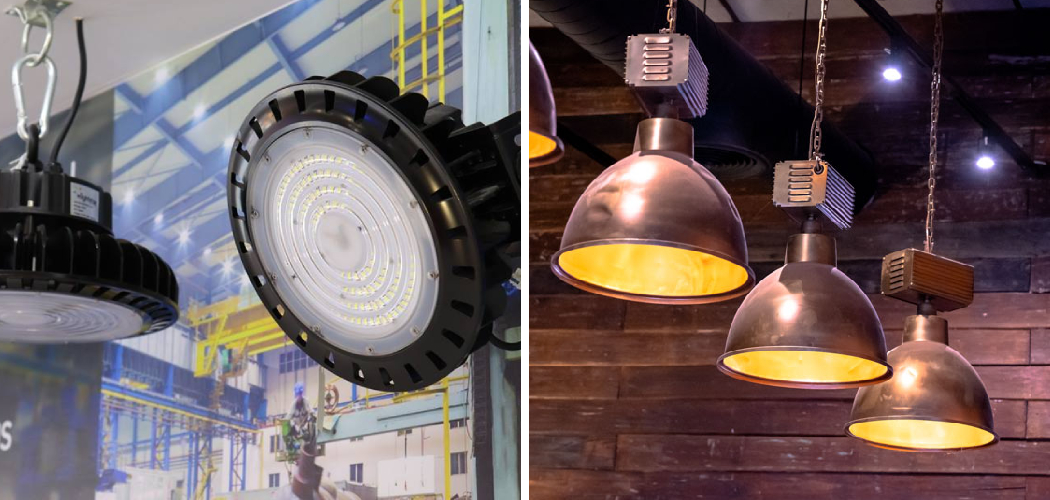High bay lights are essential in warehouses and other commercial settings where high ceilings are needed. Proper installation is the key to ensuring you get the most out of your high bay lights.

In this blog post, we will go through the steps to help you hang your high bay lights securely and efficiently. So keep reading to learn more about how to hang high bay lights.
Can You Hang High Bay Lights?
High bay lights are essential to commercial spaces such as warehouses, gyms, and factories. They provide bright and consistent lighting to large areas, ensuring optimum visibility for work and safety. However, the installation of high bay lights can seem daunting to the uninitiated.
The question on everyone’s mind is, can you hang high bay lights? The answer is a resounding yes! With the right equipment and knowledge, anyone can install high bay lights.
Not only will these lights enhance the functionality of your workspace, but they will also improve the overall aesthetics of your building. So why wait? Get ready to elevate your lighting game and add some much-needed brightness to your commercial space!
Why Should You Hang High Bay Lights?
The importance of proper lighting cannot be overstated, especially in environments where large areas need illumination. Installing high bay lights may be the solution to improve lighting in your workspace. High bay lights are ideal for warehouses, manufacturing facilities, and other large commercial spaces.
Hanging high bay lights could significantly enhance visibility and ultimately boost productivity in these environments. These lights are also energy-efficient and can help to save on electricity bills. By enhancing visibility, these lights could reduce the likelihood of accidents and injuries, increasing the safety of employees.
Hanging high bay lights can have a significant impact on your business’s bottom line, improving employee productivity and safety while saving money on energy costs.
How to Hang High Bay Lights in Your Warehouse – in 7 Easy Steps
Step 1. Safety First
Before starting any project, safety should always come first. When hanging high bay lights, it is crucial to follow all safety protocols. Make sure that the area where you will be working is clean and free from obstacles. Avoid working on your own and, if possible, have someone nearby in case of accidents. Use safety gear, such as gloves, safety glasses, and hard hats, to protect yourself from potential hazards.

Step 2. Choose the Right Height
The height at which you hang your high bay lights is essential for their effectiveness and energy efficiency. Generally, high bay lights should be installed at least 15 feet above the floor. Having them too low doesn’t allow the light to spread evenly while having them too high can make them less effective.
Avoid installing your high bay lights where they might interfere with moving equipment or where they can be bumped or damaged.
Step 3. Attach Mounting Brackets
The next step is to attach the mounting brackets to the ceiling. This should be done according to the manufacturer’s instructions. Make sure that the brackets are securely attached and can hold the weight of the light fixtures. For safety reasons, double-check the fixing and ensure that the brackets are level.
Any gap at the time of mounting can cause an uneven sag of the fixture over time and can also cause performance issues.
Step 4. Connect Wiring
Once the brackets are fixed, it’s time to connect the wiring. Before doing this, turn off the power supply to the light fixtures. Connect the wiring from the light to the circuit breaker. Check the voltage using a Multimeter to avoid overloading the circuit and damaging the fixtures. In case the wiring is faulty, hire an electrician or professional to fix it for you.
Step 5. Install the High Bay Lights
The next step is to install the high bay lights themselves. Take the light fixture and line it up with the mounting bracket, ensuring that it is secure. Avoid overtightening the screws and, if applicable, follow any additional instructions provided by the manufacturer. After ensuring everything is tight and secure, switch on the power and test the lights to ensure they are working correctly.
Step 6. Adjust the Mounting Bracket
To ensure optimal performance, you should adjust the mounting brackets of your high bay lights. The angle at which they are placed can drastically change the efficiency and performance of the light fixtures. If the bracket is installed at an incorrect angle, try adjusting it to see if it helps improve lighting in the area.
Step 7. Ensure Proper Maintenance
The last step is to ensure that you maintain your high bay lights properly. This means cleaning them regularly and checking for any signs of damage or wear and tear.

You should also inspect the wiring and mounting brackets periodically to make sure they are in good condition and can hold the weight of the fixtures. By doing so, you can ensure your lights are working correctly and efficiently for many years to come.
That’s it! You’ve now learned how to hang high bay lights correctly. Follow these steps, and you’ll be able to install your light fixtures safely and effectively.
5 Considerations Things When You Need to Hang High Bay Lights
1. The Size of the Area You Need to Light
The first thing you need to consider when hanging high bay lights is the size of the area you need to light. High bay lights are typically used in large industrial or commercial spaces, so you need to make sure that the lights you choose are powerful enough to light the space adequately.
2. The Ceiling Height
Another important consideration is the ceiling height of the space you are lighting. High bay lights are designed to be hung from high ceilings, so if your space has a low ceiling, you may need to choose a different type of light.
3. The Wattage of the Lights
When choosing high bay lights, you also need to consider the wattage of the lights. The wattage will determine how bright the lights are, so you need to make sure that you choose lights that are powerful enough to light your space adequately.
4. The Type of Lighting You Need
There are two main types of high bay lights: fluorescent and LED. Fluorescent high bay lights are less expensive than LED lights, but they are not as energy efficient. LED high bay lights are more expensive than fluorescent lights but are more energy efficient and have a longer lifespan.
5. The Cost of the Lights
Finally, you need to consider the cost of the high bay lights you choose. High bay lights can be quite expensive, so you need to make sure that you choose ones that fit within your budget.
5 Benefits of Hang High Bay Lights
1. More Efficient
Hang-high bay lights are more efficient than traditional ones, as they produce less heat and energy. This makes them ideal for use in warehouses and other large commercial spaces.
2. Longer Lasting
Hang-high bay lights also last longer than traditional lights, meaning that you won’t have to replace them as often. This can save you money in the long run, as you won’t have to keep buying new lights every few months or years.
3. Better for the Environment
Because they are more efficient and last longer, hanging high bay lights are also better for the environment. By using less energy and producing less waste, they help to reduce your carbon footprint.

4. Safer
Hang-high bay lights are safer than traditional ones, as they produce less heat. This means there is less of a fire risk when using them.
5. Easier to Install
Hang-high bay lights are easier to install than traditional ones, as they require no special wiring or fixtures. This makes them ideal for use in difficult-to-reach places or areas where installation would be difficult.
Some Common Mistakes People Make When Trying to Hang High Bay Lights
When it comes to industrial lighting, high bay lights are the perfect choice for large spaces with high ceilings. However, improper installation can lead to safety hazards and ineffective lighting.
One common mistake people make is underestimating the weight and number of necessary fixtures for the space. Another mistake is hanging the fixtures too low or too high, which can impact the quality and coverage of the light.
Additionally, failing to secure the fixtures properly can lead to dangerous accidents. It’s important to consult with a professional electrician and follow manufacturer guidelines to ensure proper installation and maximum efficiency. By avoiding these common mistakes, your high bay lights will illuminate your workspace safely and effectively.
Do I Need a Professional to Install High Bay Lighting?
Installing high bay lighting can seem like a daunting task, especially for those who lack electrical experience. While some DIY enthusiasts may be tempted to tackle the installation themselves, it is important to note that professional installation is recommended to ensure the safety and efficiency of the lighting system.
High-bay lighting fixtures can be heavy and difficult to maneuver, and improperly installed fixtures can lead to serious safety risks, such as fires and electrical shocks. Additionally, professional installers have the expertise to properly wire and configure the system to optimize performance and energy efficiency.

So, if you’re considering installing high bay lighting in your space, it’s best to leave it to the professionals to ensure a safe and effective installation.
Conclusion
Installing high bay lights in your warehouse or commercial space is essential for lighting and visibility. Follow these easy steps to hang high bay lights appropriately, efficiently, and safely.
Keep in mind that proper installation is crucial in ensuring the longevity and effectiveness of your high bay lights. If in doubt, do not hesitate to seek professional support, and always prioritize safety. Thanks for reading our post about how to hang high bay lights.

